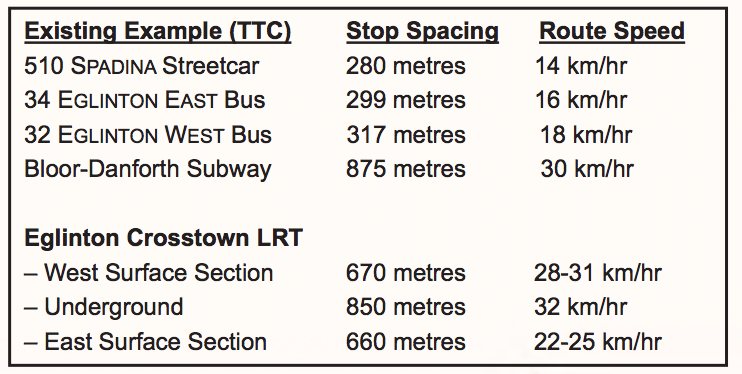The worst part about Rob Ford’s attitude toward transit planning is how damn simplistic it is. It’s inspired by a few things: a poll he saw during the campaign that showed Torontonians prefer the city’s subway system to its streetcars, his own frustration over getting stuck behind surface transit vehicles when driving from Etobicoke to City Hall, and populist rage over delays and mismanagement — real and imagined — on St. Clair West during the recent right-of-way project. (As if the damning factor on St. Clair was that it was surface rail and not, you know, all the unrelated things that went wrong during construction.)
Everything else — even cost-benefit analysis! — takes a back-seat. It’s easy to get angry about this approach. It’s short-sighted and backward and not befitting of the City of Toronto as I know it. But then: this is the mayor we elected. So it goes.
Lots has been written about the supposed ‘death’ of Transit City over the past few days. And while I hold firm to my belief that the outcome we’re facing isn’t abjectly terrible, Â I do think it’s worth taking some more time to point out what we lost with this week’s announcement:
Transit City would have transformed the city’s avenues
Soon after the new transit plan was announced, effectively killing the Sheppard East LRT that would have opened in 2014, InsideToronto’s Mike Adler reported that the Sheppard East BIA was very unhappy:
There was no satisfaction, though, for Mark Bozian, chairperson of the Sheppard East Village Business Improvement Association, which represents merchants east of the planned Sheppard route.
The merchants cooperated with the city for three years on the shelved Sheppard East LRT project, hoping to gain valuable streetscape improvements as it was completed.
Faced with a new plan under Ford, BIA representatives made their case to Karen Stintz, TTC board chairperson, and to Councillor Doug Ford, the mayor’s brother.
Councillor Ford seemed to accept an invitation from the merchants to tour the area, but hasn’t followed through, said Bozian, “which is very disappointing.”
Bozian added the BIA may have to appeal to Toronto Council to get the improvements merchants feel they deserve. “We’re going to have to exercise a different route now to have our three years of hard work recognized by the city and the TTC,” he said.
via InsideToronto Article: Eglinton rapid transit expected to benefit central Scarborough.
A critical difference between above-ground and below-ground construction is that above-ground construction tends to bring general streetscape improvements. Things like bike lanes, new paving, new sidewalks, light standards and poles were all supposed to be part of Transit City construction, along with zoning changes to promote mid-rise mixed-use development. Transit City was about transforming neighbourhoods in addition to increasing transit capacity.
It remains to be seen if the Eglinton Line, all underground, will bring any on-street improvement to that stretch.
Transit City was designed to bring transit to priority neighbourhoods
Not lost on those who remember the original Transit City map, as revealed back in 2007, is that it would have brought two transit lines to the intersection of Jane & Finch. It also would have brought transit to the priority neighbourhoods of Jamestown, Malvern, Weston-Mt. Dennis, Flemingdon Park, Steeles-L’Amoreaux, and others. The Eglinton line will still provide much better service to those in priority neighbourhoods who live along that route, but it doesn’t do much for many others, particularly in the northwest and northeast corners of the city.
And, as noted above, the transformative on-street improvements these areas would have seen under Transit City are likely lost now, under the ‘no above ground transit’ edict.
Transit City was the beginning of an affordable network
This should be what gets self-described ‘fiscal conservatives’ to stand up and take notice. Operationally, Transit City was a budgetary dream because it generally would have reduced or sustained current labour costs. If you replace buses in service on a route 1:1 with light rail vehicles you vastly increase the reliability, capacity and speed of transit, but you’re still just paying one operator to drive the vehicle. With on-street stations, there are no staffing costs there either. Underground transit, by comparison, is far costlier on an ongoing basis.
On the capital side, while the start-up cost for the Transit City network was high, once completed the city would have been in a position where transit expansion could be affordable without significant provincial funding. With a fleet of vehicles, storage yards, and a base network of trackage, we could have embarked on a continuous expansion program. Not only does light rail cost far less than subway on a per-kilometre basis, it’s also more flexible. Spur lines (like was proposed for the Sheppard LRT to the University of Toronto Scarborough campus) and incremental expansion are cheaper, and come in chunks small enough that they could fit into the city’s capital budget.
Transit City wouldn’t have flushed away 49 million dollars
And, lastly, there’s this:
Toronto is currently on the hook for at least $49 million for cancelling the Transit City light rail plan, says the head of the regional transportation agency tasked with implementing Toronto Mayor Rob Ford’s new transit plan.
That outlay is likely to rise, said Bruce McQuaig, the CEO of Metrolinx. The city would have to pay for any penalties incurred for breaking or altering contracts secured in the previous Transit City plan, he confirmed.
via Toronto must pay at least $49M to cancel LRT plan – Toronto – CBC News.
This $49 million (or more) represents the biggest outlay of wasted taxpayer money in recent memory. When you consider the staff time spent at the TTC over the past number of years working on these plans, that number is likely an order of magnitude higher. Speaking as a taxpayer, this isn’t what respect looks like.
